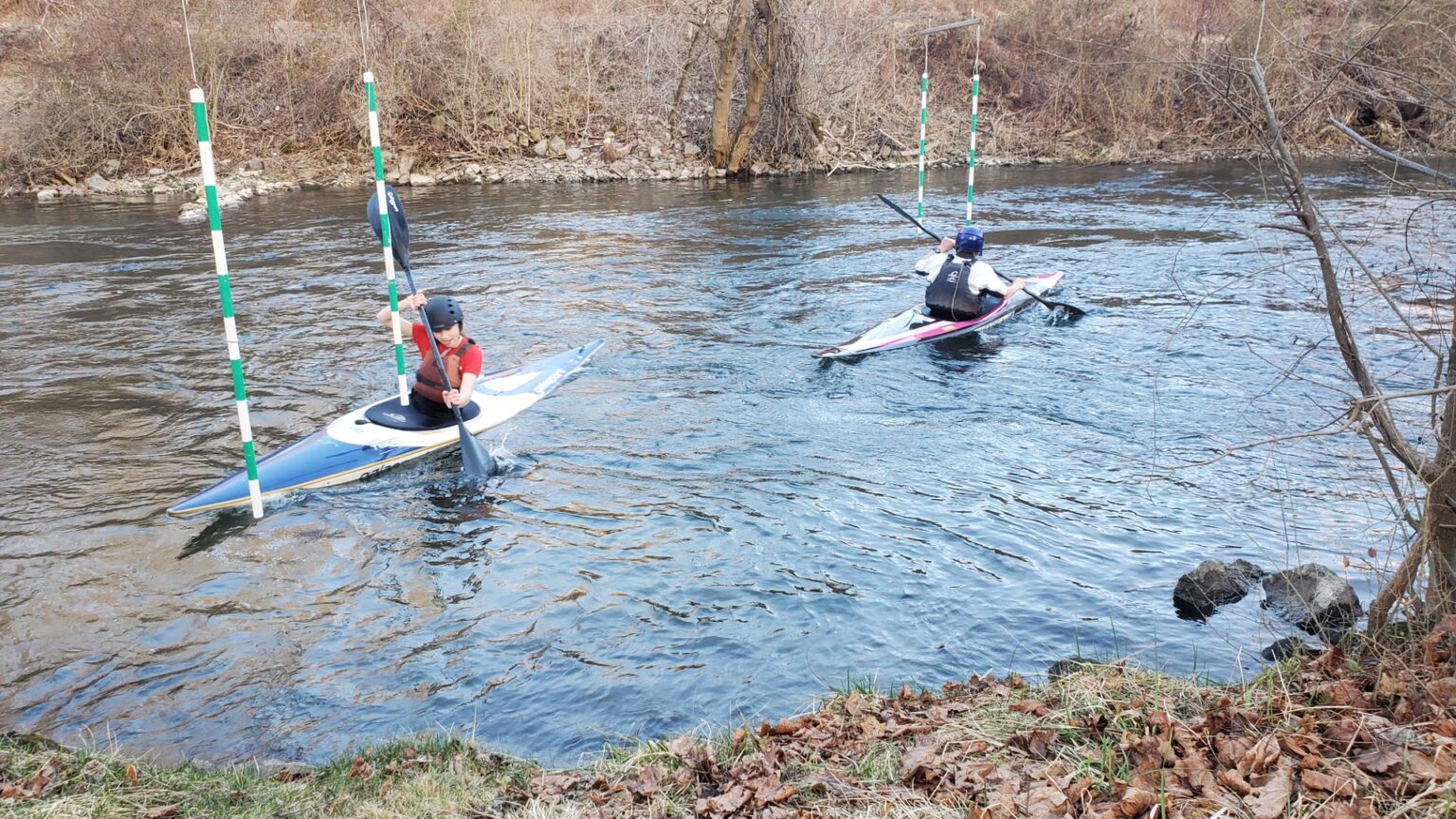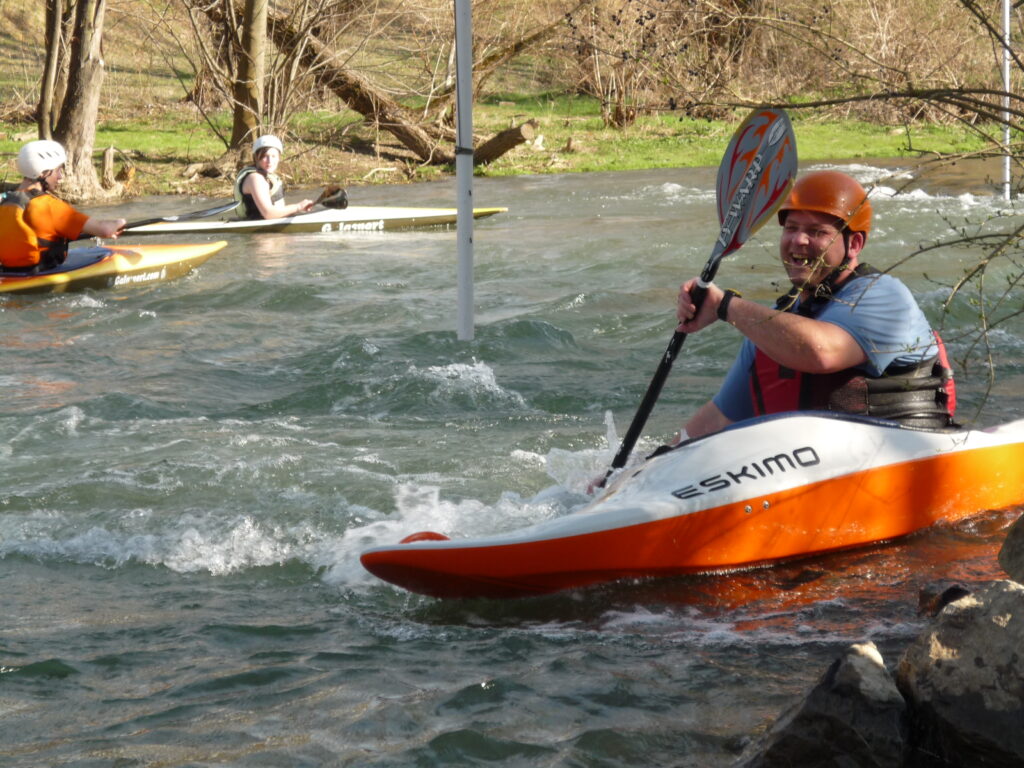
Sunnyside Paddling Park (Photo courtesy of David Kurtz)

Sunnyside Paddling Park (Photo courtesy of David Kurtz)
By David Kurtz
Who would have guessed 60 years ago that a short stretch of Spring Creek in Bellefonte would become a top training ground for whitewater paddling, perhaps the best in the United States? But that is what happened.
It all started in the summer of 1961 when Boy Scout Explorer Post 32 was holding a coed slalom on the West Branch of the Susquehanna River just north of State College. We had prepared the slalom poles, which were colored with green or red stripes, and they were packed in the station wagon at the Presbyterian church in State College. Along came Natan Bernot from Yugoslavia, who was studying nuclear engineering at Penn State. Bernot had scored second place in events in doubles canoe at the 1961 World Championships. He talked to a couple of the boys and they, in turn, invited him to our event. He accepted.
In my mind, Natan Bernot was a “wild paddler.” In Penn State Outing Club river cruises, he always had to empty water from his open canoe after running rapids. He was used to a decked canoe. Well, I couldn’t negate the offer, and he came to our event. It changed the direction of my life. Natan helped us set our gates and then paddled doubles canoe with some of the boys.
At the end of the event Natan made the statement, “If you kids had a good decked canoe, you trained, and learned the Eskimo roll, you could go to a world championship some day.”
“Really, Natan, that is a pretty big wish,” I said.
A couple of months later, I received in the mail a roll of paper on which there were 1:1 drawings of a new singles canoe to be made of fiberglass and resin.
To shorten the story, 16-year-olds Dave Guss and Tom Southworth and I made a wooden model of the canoe (which is now in the Dave Kurtz Canoe and Kayak Museum in Bellefonte) We made the mold of glass and resin, and three canoes were pulled from the mold. We learned the Eskimo roll in the pool in the Glennland Building in State College. In qualification slaloms later on, we smashed the competition that were paddling in aluminum canoes and earned positions on the 1963 U.S. National Team. The World Slalom Championships that year were on the Lieser River near Spittal an der Drau, Austria.
At the Worlds, I ended up in 17th place with a score of 589, and Dave Guss found 19th place at 620. Southworth reached 21st place at 778, accomplishing five Eskimo rolls in one of his runs.
It was clear the Americans had a long way to go to be competitive in the Worlds scene. We decided we had to practice on a daily basis instead of just on the weekends.
On our return home, I paddled Spring Creek, the nearest moving water location around Bellefonte, to look for places to hang slalom gates. I found it below the Lamb Street Bridge on the Bellefonte-Spring Township border, and the rest is history.
We made a slalom course by stretching several wires attached to trees or bushes and hung makeshift slalom gates. Each gate consisted of two poles hung f48 inches apart and close to but not in the water. Early on, when we returned on another day, we found the gates in the water. Day after day. Eventually others got used to their presence and stopped the removal and it was a time saver for us.

The features of the Sunnyside Paddling Park are modeled after what we saw in Europe. In those countries, the schools did not sponsor athletic teams. Teams came about through the towns and cities. In addition to the slalom gates over the river, there were usually several buildings. One would hold a variety of kayaks and canoes that were available to any interested person. Another would be a workshop for boat and paddle repair. A third would have changing rooms and restrooms along with all sizes of clothing and paddle equipment. European paddling areas also usually have a restaurant.
All of these features are present at the Sunnyside Paddling Park. In addition, there is year-round water. The gated stretch has three features: at the top is fast water of a Class II strength, in the long middle stretch are only fast currents of Class I, and at the bottom another Class II stretch as the stream makes a two-foot drop over a crossing sewage pipe line.
Hence we can start a new person who would have no equipment of his own. One can pick out a kayak or canoe size fitting the person from an assortment of fiberglass slalom boats or plastic boats. There are helmets and a variety of paddles, hand mitts and even sweaters and paddle jackets for colder weather. There is no restaurant there, but we have food and a microwave to heat it, along with drinks in a refrigerator.
We think the Sunnyside Paddling Park is the best beginner paddling area in the United States.
Paddling Merit Badge Program for Scouts
The Sunnyside Paddling Park in Bellefonte will be the scene in June for intense paddling on the part of Scouts working on and completing the three Boy Scouts of America paddling merit badges: Kayaking, Canoeing and Whitewater.
The plan is to create practicing and testing activities the last three weeks of June—essentially, after school finishes. The location will be the Sunnyside Paddling Park on Spring Creek in Bellefonte. The Mach One Slalom Team, located there, will be the host and provide the leadership. The team has available a host of kayaks, slalom canoes and even an open canoe or two. We have available a large number of life jackets and helmets as well as dozens of paddles and even sweaters for warmth if needed. Our headquarters is available for discussions and use of the refrigerator, freezer and microwave. The headquarters is also available to use in case of thunderstorms and other weather disturbances.
In the past 25 years we have trained 258 youth boys, 84 youth girls and 77 adults in the whitewater sport. Several boys and girls, starting as young as 7 years old, have gone on to participate as United States Juniors in World Slalom and Wild Water Championships.
A small charge will be asked for wear and tear of the equipment. We work in small groups of no larger than five boats, which gives us excellent control of the boats at the park.
Scouts and Scoutmasters who would like to get the ball rolling should request the Merit Badge Registration Form by emailing [email protected]. T&G
David Kurtz is creator of the Sunnyside Paddling Park. He also works on putting together the Dave Kurtz Canoe and Kayak Museum in Bellefonte.
Receive all the latest news and events right to your inbox.

80% of consumers turn to directories with reviews to find a local business.